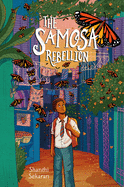
On the fictional South American island of Mariposa, the government has suddenly begun drawing strict lines between Butterflies, the "true" citizens of Mariposa, and Moths, immigrants. Division leads to oppression and eventual uprising in Shanthi Sekaran's inspirational middle-grade debut, The Samosa Rebellion.
Sixth-grader Muki lives with his parents and his recently arrived Paati (grandmother) on Mingus Avenue, a poor neighborhood in the otherwise prosperous Mariposa. His dad was a scientist in India, but now works with his wife running a bodega-style store that specializes in homemade samosas. As Paati settles into life in Mariposa, Muki notices a disturbing trend that has come along with increased immigration: the government, which had once considered everyone a Butterfly, now strictly states that anyone whose family hasn't lived in Mariposa for three generations is a Moth. "Butterflies are from here.... And moths aren't. But they compete for the same... nectar." When Muki and his friends discover a hidden site--a detention camp being set up outside of town to house Moths--they wonder if anyone will listen to an alarm sounded by a bunch of kids. Can anyone stop the Butterflies?
In The Samosa Rebellion, Sekaran (Lucky Boy) creates an accessible and thought-provoking look at xenophobia and systemic racism. While teens and pre-teens fighting against a corrupt government may not be new territory, Sekaran's imagined Mariposa provides new ground and gives solid reasoning behind children being involved: "Kids make the best revolutionaries, because rebellion runs in our veins. We have crazy ideas that sometimes actually work, and nobody cares about stuff more than we do." The Samosa Rebellion soars with powerful, intentional, timely messages of acceptance and tolerance spliced with playful humor. --Kyla Paterno, freelance reviewer

